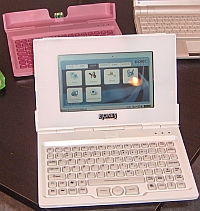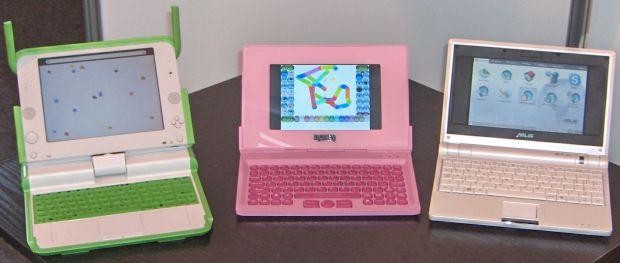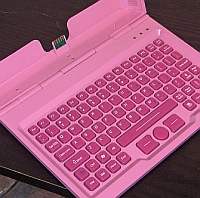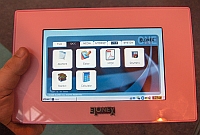I was in Birmingham today for my nephew's first birthday, just after lunch I nipped out to visit the Education Show which was running on the other side of town in the National Exhibition Centre.
The purpose of my visit was to see the Elonex One which was launched on Wednesday. I had emailed in advance to check they were OK with me bringing along an XO and an Asus EeePC.
Not only were they OK with it, they were delighted to see the other Linux based laptops I had brought and took loads of photos of the three little friends. Apparently Walter Bender had flown over to visit them the day before, but curiously my XO was the first that they had seen, I guess Walter didn't bring one with him.
On the stand they had the One in pink, white, grey and black, I had a play with the pink One.
The One is a little thicker than the XO and EeePC, but weighs about the same. The computer is behind the screen, just like the XO, rather than under the keyboard like the EeePC. It is a really interesting form factor, the keyboard and hinge is detachable and plugs into a little USB socket on the base of the main unit, so it isn't a wireless keyboard, but they are considering a bluetooth keyboard for the future.
Initially I thought there was no hinge, but there is one, it is part of the keyboard unit. The hinge looks fine, but on all clamshell laptops the hinge is the weakest part. If this one breaks you would simply get a new keyboard unit for just a few quid. The screen is a nice bright 800x480 LCD under the smooth glass(or it could be plastic I guess) front.
The weight of the XO screen leans on the battery and handle, on the One there is nothing behind it to lean on, so they have added a little stand, kind of like a picture frame stand. They were quite interested in the dual mode screen of the XO, maybe Pixel Qi could help them out here . . .
The keyboard is a rubber membrane affair, like the XO, but the rubber feels a little thicker and chunkier, there is a plastic overlay with holes in for the keys to poke through, it is more like the keyboard on the old Spectrum 48k. The mouse is a joystick rather than a touchpad, I think this might be better for grubby fingers.
A really nice touch is the second mouse on the back of the screen unit. This means you can navigate about in tablet mode, it actually felt really natural to hold it in two hands and use the mouse.
On the side are the usual complement of headphone, microphone, USB ports, the little black wheel is a tilt wheel thingie, they described it as like a Blackberry wheel so you can scroll up and down and click it to select things. I guess it acts as a mouse wheel and middle mouse button.
Inside it has an AMD processor running at 300Mhz, so it is a bit slower than the XO, however the screen resolution is lower so it might have a bit less work to do. There is 1gig of storage and 256mb of ram.
As well as the internal storage they are providing rubber USB wrist bands to provide more storage and a handy transfer device I think they may have to make them a bit smaller for the kids, but it fits me just fine. The software is based on Debian Linux and they have a graphical front end somewhat similar to the EeePC with tabs grouping sets of big chunky icons.
I wish them all the best with their new product, it is innovative and well designed, it deserves to do well. All these little Linux based laptops should not be seen as competitors with each other. They are a whole new class of device and they are all delivering on the vision of a single laptop per student.
I got back to the birthday party just in time for the cake. Happy first birthday Rhys and happy zeroth birthday Elonex One!
Alan Bell reminds you that you can BETT on a Guest Post happy ending when you write for OLPC News.






but...I wanted to hate it!
Goshdarnit, that 'ol private sector keeps churning products that people *actually* want, except for Stallman of course. I hear he won't drink milk because the cows refuse to GPLv3 their teats . . .
Man Oh Man, what's to become of the Non-profit manufacturing sector? I guess them boys from OLPC can always join me down on my ranch here in Texas in case things don't work out w/ that there cute little XO. I've got a mesh network of bulls and I swear they use XMPP to find the location of the Heifers.
Yours Truly,
Hank Witherspoon
Beaumont, Texas
Part-time Hacker and full-time Rancher
Hi,I was thinking of getting one,
are they reliable and gd?
Can you use them for everyday and not just educational?
dont waste your money on these they break within 6 months, are full of faults and tech. support dont even resond when you contact them. spend a little extra, get a LOT better
@Alicia
well Linux has a very strong reputation for reliability and the hardware feels pretty solid. Most of the components have a track record in other devices, that screen features in other Elonex products and there is a digital picture frame with a similar stand and general form factor. The bit that will break first is going to be the hinge, but that has cunningly been designed to be almost disposable.
If you want a small everyday laptop for an adult then I would go for the Asus EeePC. It has a faster processor and a VGA port. For a primary school deployment then I would go for the XO or the One for the more rugged design and rubber membrane keyboards.
If you want to mostly use the One in tablet mode (i.e. without the keyboard, just using the mouse on the back) then the One might well be ideal as an adult's traveling companion, but it isn't a PC replacement.
This looks like a very interesting little device.
Understand that even while I'm rooting for the XO to lead the charge in the educational-laptops market, that doesn't mean that I have a problem with other devices being out there per se. There's more than one demographic of people who would benefit from a low-cost portable basic notebook, and I think the One will help to fill that need.
No matter how many other small laptops we've seen so far, none of them share ALL of the attributes that, IMO, make the XO an ideal tool for the environments it was designed for. No other device has the dual-mode sunlight-readable screen, enables mesh networking and collaboration in the way the XO does, boasts such low power consumption, and is dust-proof AND spill-proof.
I wonder if the XO would benefit from the hard-plastic keyboard overlay that the One has... we have a thread in the "hardware problems" forum describing how some people's three-year-olds tore some XO keys from the keyboard. Maybe a plastic overlay would make that feat harder to accomplish. Yes, the students that XOs are designed for are ages 6 and up, but since those students might have younger siblings, a little extra tot-proofing might be in order for XO v2.0.
The detachable keyboard idea makes me a little nervous -- having not seen it firsthand, I don't know how easily damaged that hinge area might be. That doesn't sound like the most small-kid-proof or accident-proof design feature, though I suspect that older kids, teens, and adults should be able to make use of that feature without major incident.
All in all, like I said, it looks like a very interesting device. My inner geek wishes I could see a One in person, especially if I have my XO in tow so I can view their performance side by side.
Here is another one:
http://ink-media.com/
The processor is an ARM from Freescale (Motorola) meant for very high end cell phones, but it is also great for this kind of computer. The OLPC complaint that ARMs don't do floating point doesn't apply here as it has a nice vector unit (and so should outperform the Geode for properly compiled applications).
Now as a trumped-up city boy, I'd like to say that many companies wouldn't have entered the "low power low-cost mini-laptop" market had OLPC not showed them there was a market 2-3 years ago. ESPECIALLY one targeted for education. Before then, sub-notebooks were sold as boutique items from Sony or IBM/Lenovo, not as educational aids for children.
Now, the killing Asus is making on the EEE proves to me that there is a market for affordable, rugged, "utility laptops" for the average person. Wasn't UMPC/MIDPC's supposed to be targeting this? Oh wait, they're all over $1000. Still.
@Jecel
Not to be a hater, but lots of things outperform the Geode, it's a little poky. But for OLPC's needs, it was the best choice at the time (price/performance/power). Not to mention that "everything already running on x86" reduces software porting headaches. I think we need new processor designs to address this burgeoning market segment. How powerful can a processor be while keeping power usage, heat dissipation and costs low?
J. McNair,
it so happens that I do design processors for this market segment. I also do the rest of the hardware, software and mechanical stuff as well. See this model from 2001 and it might look familiar:
http://www.merlintec.com/merlin6/e_main.html
Jecel wrote:
"it so happens that I do design processors for this market segment. I also do the rest of the hardware, software and mechanical stuff as well. See this model from 2001 and it might look familiar:
http://www.merlintec.com/merlin6/e_main.html"
That one is an updated version of this, the original and real one (the 2001 model):
http://web.archive.org/web/20011216223327/www.merlintec.com/merlin6/e_main.html
Their web page says 128MB standard, 256MB optional. They seem to have an SD slot too.
To save you all some googling: 1 British pound = 1.9846 U.S. dollars so it costs $198 retail (I assume) VS $180 in mass quantity for the XO. I'm impressed they squeezed a profit margin into that. Isn't a typical markup around 40%?
Irvin,
thanks for posting that link. This is work in progress and the design does change as time goes by. I am currently working with FPGA development kits but will get back to designing my own boards soon. Anyone interested in a more complete history of my changes can look at:
http://www.merlintec.com:8080/hardware/album
(this wasn't working properly since I changed ISPs two weeks ago, but I just tested it and it seems ok)
I wrote: "it seems ok", but it is still broken. Most of the images on that page are on other servers and that is why they loaded.
I wrote: "it is still broken", but after multiplying by ten all limits in a silly Intrusion Detection System my ISP hid inside my ADSL modem, it should be working.
"Goshdarnit, that 'ol private sector keeps churning products that people *actually* want, except for Stallman of course. --Hank Witherspoon"
Stallman started free software exactly so that companies like Elonex and Asus could make cheap hardware with hackable software. These companies are the realization of Stallman's dreams and work.
"Part-time Hacker and full-time Rancher"
... and an embarrassement to both.
bought 2 elonex ones for my daughters and please be warned DONT WASTE YOUR MONEY...they dont last 6 months, the software is full of faults and flaws and when you try to contact technical support they dont respond or just cut you off.
Can you put other software on it? I would suggest Sugar on a Stick - best for your daughters anyway